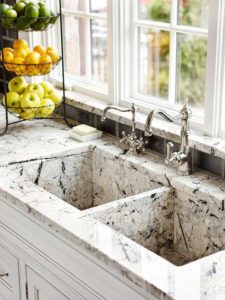Everyone has an opinion about the right kind of kitchen sink. From black to white, farmhouse to stainless steel, there are a multitude of options. But the question everyone should be asking themselves during the design phase of their kitchen renovation is: which works best for my everyday life? In order to answer that, let’s look at some basic options below.
Kitchen sink materials
Stainless steel 
The most common material used over the years during kitchen renovations is stainless steel, which is a proven material that can take a beating and resist stains over time. Stainless steel is also very affordable.
One item to consider when choosing a stainless-steel option is the gauge of the steel. This pertains to the thickness of the steel used in the sink. You can’t really go wrong choosing a standard gauge, but some people find that a slightly heavier gauge of steel can be less noisy and resist denting.
 Granite Composite
Granite Composite
For a more luxurious look, granite composite sinks are available that provide a smooth surface that will complement your countertops and provide good durability. For a bold and sleek look, choose a black option to really make your kitchen stand out.
Ceramic / fireclay
Finally, ceramic and fireclay are very popular right now because of the farmhouse kitchen trend. These vary in price and offer a classic look and feel to your kitchen. They also come in a variety of sizes and depths to match your needs.
Part of the popularity of farmhouse installations is that they offer large sizes and this is a blessing for anyone who has felt the frustration of trying to wash an extra-large pot in a traditional installation. However, it should be noted that stainless steel sinks also come in similar styles and sizes to farmhouse options, and so you should always compare your options before making a final decision.
Types of installations
Undermount installations are where the lip of the sink is below the countertop. This allows the appearance of your countertops to be continuous, without an edge sitting on top and interrupting the flow. It also allows water to flow from the countertop into the basin and not pool around any raised edges. For an undermount installation, use granite, marble or quartz countertops as they are stronger and can support the undermounted sink. Laminate and tile countertops are usually not the best for undermount installations.
Top Mount installations are the ones that most people are familiar with where the lip of the sink sits on top of the countertop.
Apron sinks are what are known as farmhouse installations. One full side of the sink is visible on the front. The color and size of the sink is extremely important for these installations since the apron takes a central visual role in the kitchen.
These apron installations also require coordination with the cabinetry and so consultation with a kitchen designer is advisable so that proper measurements are taken and the installation goes smoothly the first time.


